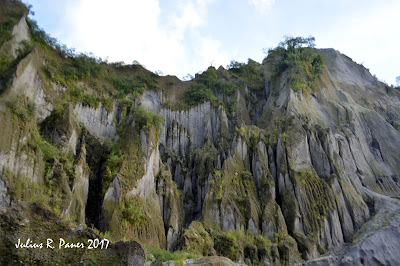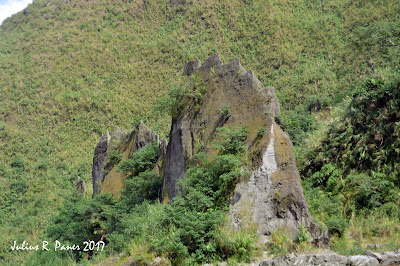I
have personally observed the troubles of the Aetas in the foothills of Mt.
Pinatubo when I hiked the mountain last November 19 in line with my
participation to the Northphil Tourism Exposition held in Clark, Angeles City
Pampanga. Their co-existence and survival for 26 long years after a tragic
outbursts is very evident as I gauged their subsistence until today based on
how they eke out a living without the so-called “ecosystem services” that were
provided to them by the good mountain prior to its eruption in 1991.
Physically,
the eruption damaged thousands of hectares of agricultural lands in areas
bordered by the provinces of Tarlac, Pampanga and Zambales. After lahars and cobblestones overlayed the green mountain
ranges the opportunities for livelihood through farming were all swayed out as
well. Even structures and settlements surrounding Mt. Pinatubo were scrubbed
out by volcanic cruelty. The trails going to the crater are wide lahar remnants
which have formed into multiple gullies where rainwater gushes anywhere else
downstream. Biodiversity is nowhere to be found in Mt. Pinatubo and the
agriculture sector is literally dead.
The
lone economic opportunity left for Mt. Pinatubo is tourism. It is a good model
for Dark Tourism, a concept being honed by for localities which is being
assailed with catastrophic experiences but stood out very well and became a
popular destination showcasing leftovers of a disaster. The 18 kilometers 4x4
off road ride from sitio Sta. Juliana, Capas to the jump off area is quite
tedious which is being tinted by an exciting 7-kilometer plain to moderate
terrain trek. Nonetheless, the majestic crater at the top is very rewarding.
Some
interesting facts surround Mt. Pinatubo crater as well. Being the deepest lake
in the country nestled 996 meters above sea level, the crater also distincts
itself as a beautiful tombstone behind an obnoxious and fatal experience. I
have yet to see a lake all over the country as splendid and mystical as that of
Mt. Pinatubo crater lake.
Despite
several success of the tourism industry in Mt. Pinatubo, the economic dilemma
of the Aeta tribe is very obvious up to these days and remains a big challenge.
To some extent the primary local dwellers of Pinatubo are all below the poverty
level. I had some casual talks to some of the tour guides there and I learned
that they are earning very minimal income because most of the community members
also do similar means of livelihood. The magnitude of guides as against the
arrivals could hardly suffice with the villagers’ basic needs which to me
immediately demands further and more receptive economic options from the local
and national government agencies.
With
the outlying locations of primary learning institutions in Mt. Pinatubo the
Aeta children are almost deprived of basic education services. Some of them
just settled along the trails hoping that tourists will buy their stuffs or
give them endowment while resting in their cute stone files located beside the
trails. Some kids sell ice candies and other food items in key stopover
stations. If only given enough attention I believe the Aetas are a good breed
of Filipino citizens who could very well be an added asset to the already-chequered
Philippine cultural subdivisions. I saw it in the way they behaved while I
listened to their sentiments during our humble conversation.
They
say everything happens for a reason and the eruption of Mt. Pinatubo is no
exemption. All the avatar-like sceneries along the trail of Mt. Pinatubo that
were formed after its eruption is a testament that there is indeed magnificence
after a tragedy. In terms of ecotourism Mt. Pinatubo now is one of the bests in
Central Luzon. However, the economic troubles of the Aetas after 26 long years have
been addressed like a snail mail. Unless government functionaries can craft good
livelihood programs of the Aetas with the prevailing tourism activities in the
area then we could safely say that certainly tourism is an all-encompassing
industry.
P.S.
The Northphil Expo which happened in SM City Clark was a 3-day tourism trade
show showcasing nationwide destinations in the Philippines. Davao Region was an
active participant of the expo through the Visit Davao Summer Festival (VDSF).
Sta. Cruz events for next year were also marketed, to be particular the two
extreme races scheduled in April 2018 – the Mt. Apo Boulder Face Challenge and
Mt. Apo Sky and Vertical Race.
Gratitude is due to
Department of Tourism XI Regional Director Robby Alabado for insisting that a
Mt. Pinatubo hike be integrated into the schedule for us to experience a
Luzon-based hiking activity; and to VDFS through its Executive Committee
Chairperson Benjie Lizada and Miss Tessa Piansay (Executive Director) for
facilitating the entire expo events.























No comments:
Post a Comment